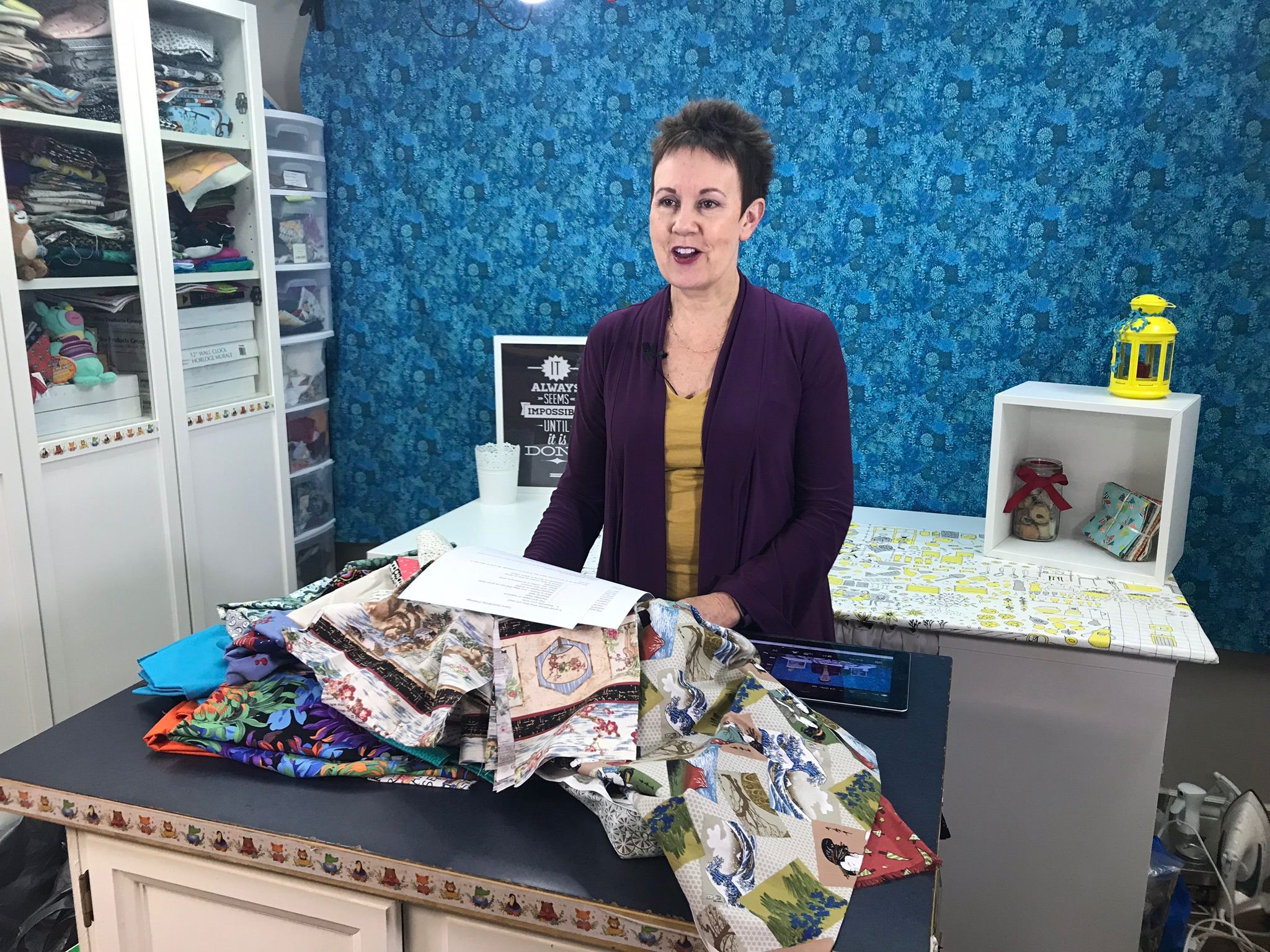
CHATTERBOX QUILTS’ BLOG
Helping Quilters Learn and Improve
Quilting is harder than it looks on quilting videos
When I watch a quilting video, the teacher always seems so calm. Everything runs smoothly and any little hiccup is met with a small chuckle and an amusing comment. We all know that is not what real quilting is about.
When I watch a quilting video, the teacher always seems so calm. Everything runs smoothly and any little hiccup is met with a small chuckle and an amusing comment. We all know that is not what real quilting is about. I would hazard a guess the most quilt studios have been witness to at least one massive meltdown and have echoed with the sounds of the English language being used in ways not appropriate for civilized company. It has been my experience that the same creativity that can result in a one-of-a-kind quilt is sometimes used to express the quilter’s frustrations in creative and unusual sentence structures.
Real quilters know that there is always going to be times when a project is just not going well. No matter how hard you try, the situation does not seem to improve and the frustration just builds. This is the moment in the video where the director calls cut and everyone takes break to regain their equilibrium before restarting the filming. Unfortunately real quilters do not have a director to tell them to take break and they are often juggling a number of things while trying to squeeze in some quality quilting time, such as cleaning or cooking (yes, some quilters do these things as well as quilting).
Let’s compare video quilting and real quilting in a few common situations.
Thread Breaks
In video quilting, the camera stops, the teacher goes for coffee and fixes her make-up while an assistant rethreads and tests machine before the filming starts again.
In real quilting, the quilter rethreads the sewing machine, the thread breaks again. The quilter looks for new thread and rethreads the machine. The thread breaks again. The quilter reads the manual, adjusts her machine and finally starts quilting only to be interrupted by their spouse , children or pets, who are hungry for dinner.
Wrong Pieces are Stitched Together
In video quilting, the camera stops, the teacher goes for coffee and fixes her make-up while an assistant unpicks the stitching and the camera restarts.
In real quilting, the quilter stops quilting and refers to the pattern in a state of denial. After a short period of grieving she unpicks the stitching, answers the door bell, brings in the mail, restarts quilting and makes the same mistake again at which point she is interrupted by her husband (Dan the Quilter Man), children or pets, who are looking for dinner.
Are you seeing the difference yet?
Let's take a look at one more scenario for comparison.
Pressing During Quilt Construction
In video quilting, the teacher reaches below the table and brings out perfectly cut and pressed pieces for the next part of the pattern. The pieces are laid out on the table in perfect geometric order, a magic iron that requires no heat is applied to the fabric resulting in the perfect piece for the next step.
In real quilting, the quilter reads the pattern and goes looking for the material that is required for the next part. The quilter cuts the appropriate pieces and turns the iron on in preparation for pressing. Hearing a noise in the other room, the quilter investigates to find that the cat has hacked up a hairball on the carpet. The quilter returns 15 minutes later to press the fabric only to realize too late that the fusible web on the appliqué is facing up and spends the next half hour cleaning the fusible web off the iron.
..and Finally, The Clean-up
The difference between the video quilter and the real quilter is also obvious at the end of the day. When filming is done for the day, the on-line teacher leaves the set, an assistant completes the project overnight and the teacher shows up the next morning to begin filming with the completed project all ready to be displayed. Our real life quilter admits defeat at the end of the day with the quilt half done. She leaves her studio to be confronted by her family members who inform her that they are out of groceries. The quilter orders pizza, has a libation - or two - of her choice (alcoholic, of course) and goes to bed exhausted, hoping for a better day tomorrow.
No wonder real quilters aren't calm.
There is quite a difference between the "reality" you see on video compared to how real quilting actually works. You don't see the seam ripping or hear the cursing that occurred, thanks to the magic of editing, which makes everything appear easy and seamless. Video instructors never appear ruffled or upset. Don't be fooled: there is a lot of "real quilting" going on behind the scenes in instructional courses and videos.
Chatterquote: “Don’t Do Drugs – Do chocolate and an occasional glass of wine”
Creatively,
P.S. Do you strive to improve your quilting skills? Do you want to have fun doing it? Do you want to meet other quilters in a supportive, safe environment? If you answered “yes” to these questions, you need to join The Quilter’s Way. The Quilter’s Way is the only quilting membership site that includes both training and an active, supportive online community. It’s not your grandmother’s quilting circle! Don’t wait another day! Join now.
P.S. I am an Amazon affiliate and, if you purchase items by clicking through the links in this post, I will receive a small amount of commission. This doesn’t cost you any more $$$, but helps me to continue creating free content for you. Thanks!
Be Realistic in Your Quilting Expectations
I recently did a fabric decluttering challenge in my membership group, The Quilter’s Way, and found that the members really enjoyed it. While I suggested that they only tackle a small part of their fabric stash in the challenge, some participants actually tackled their entire fabric stash. I had suggested only taking on a bit of their fabric stash so they would be able to accomplish the task assigned to them in the allotted time for that day (no more than 1 hour) to avoid feeling overwhelmed and discouraged. I was glad that they got great results and pleased that they didn’t feel overwhelmed because this can be a huge task. If you sometimes take on a project that makes you feel overwhelmed or discouraged, it might be because you haven’t been realistic in your expectations of what you can actually accomplish in the time allotted.
The most important thing to do to avoid these negative feelings when working in your quilt studio is to be sure that you have realistic expectations of what you can actually accomplish in the time allotted.
Let’s say that you wanted to clean up your fabric scraps. If you are like me, you have scraps spilling out of drawers in your studio (notice that I’m already assuming you have them in some kind of storage unit!). If you thought that you could sort, cut, and organize all of your fabric scraps in one hour, you would certainly be discouraged by your results at the end of that time! The reason for this is that you didn’t have realistic expectations of what you could accomplish in that one hour allocated for this task. You may think that you can organize all of your fabric scraps in one hour, but is this really a realistic estimate of the time that it will take? I don’t think so.
Whenever you are considering working on a project or doing some task in your studio, you need to be realistic in how long it will actually take you – and then add on a bit more time. Why not try doing part of the task and time yourself to see how long it takes? Did you get as much as you expected completed in this time? Did it take you longer or not as long to do it? This will help you to determine what a realistic expectation is of what you can accomplish in the time period you’ve set aside for this task.
It’s also helpful to chunk out tasks into smaller sections. Using the scrap fabric organization project, if you decided that you were going to sort out your fabric scraps into colours, you might be able to do this in an hour, depending on the size of your fabric scrap pile. This is certainly a more realistic estimate of how long this task might take. By deciding that the only thing that you will do in that one hour is to sort your fabric scraps into colours, not only will you be able to finish that entire task in that time, but you will also have that feeling of satisfaction that comes with that accomplishment. A double win!
Click on the image below to watch a video for more information on realistic expectations in your quilt studio.
The next time that you want to work on a project, be realistic in the time you anticipate it will take to do it. Estimate the time it will take and add on some additional time. By doing this you’ll avoid feeling discouraged or overwhelmed in trying to finish them in a certain period of time.
You may be interested in the guide “Time Saving Tips for Quilters” where I have compiled a list of time saving tips. Click here is you want more information.
Creatively,
P.S. Do you want to enhance your quilting and become the best quilter you can be? If you answered “yes” to this question, you need to join The Quilter’s Way. The Quilter’s Way is the only quilting membership site that includes both training and an active, supportive online community. Don’t wait another day! Join now.
P.P.S. Did you know that you can sign up to receive emails full of FREE quilting goodness? Click here to receive FREE content directly in your email inbox every few weeks from Chatterbox Quilts. I know you'll be glad you did!
Avoid Distractions and Stay Focused When Quilting
Did you know that distractions can affect your efficiency in your quilt studio? And by distractions, I’m not necessarily talking about getting a notification every time one of your friends posts on Facebook or Instagram – although that can be a huge distraction. Let’s talk about what other types of distractions can be affecting your quilting productivity and how to avoid them.
Take a look around your quilt studio. Is everything in its place or are there WIP’s, fabric and books lying around? Okay, maybe that’s just my studio, but I’m sure that yours is sometimes in this state too. If having a messy studio bothers you, it can affect your ability to be efficient in your studio.
If there is fabric on my pressing surface that has been there ever since I bought it at the quilt show a month ago, this is a major distraction for me. I might be stitching away on a project, but once I catch a glimpse of this fabric pile, I start getting distracted. This visual distraction prevents me from working on my current project as I keep thinking, “I really need to fold this fabric and get it into my fabric stash”. This desire to put away the fabric is in the back of my mind as I am trying to work on my quilt project, distracting me which makes me less efficient. If I wanted to avoid this scenario, I should really put this fabric away as soon as I get home from the quilt show, but this never happens. It languishes on my cutting or pressing surface, getting moved around whenever I need these areas for their proper activities.
This also happens with books, patterns and magazines in my studio. I may’ve leafed through them, but I want to take a closer look when I have more time, so I leave them out on my sewing table or another area in my quilt studio. I’m afraid that if I put them away, I’ll forget about them or forget which book or magazine had that fantastic pattern in it. Again, I really should put them away after making a note of the books or magazines that I want to refer back to when I have the time.
Leaving items like these out, rather than putting them away, not only takes up working space, but creates a visual distraction. Seeing them takes your mind away from your current project and can make you feel guilty or overwhelmed. These are one type of visual distraction that can be easily remedied, by putting them away, but there is another type of visual distraction that isn’t so easily dealt with.
The décor of your quilt studio can also be a visual distraction. If you’re the type of person who needs clean space around you, yet have lots of decorative items in your studio, this might be causing you to be distracted and unable to focus on your current project. If you have a large window in your quilting space, this can provide wonderful lighting, but if you are constantly looking to see what’s going on outside, this distraction can interrupt your quilting time.
Click on the image below for a video on distractions in your quilt studio and how to avoid them.
You may be interested in the guide “Time Saving Tips for Quilters” where I have compiled a list of time saving tips. Click here is you want more information.
Creatively,
P.S. Do you want to enhance your quilting and become the best quilter you can be? If you answered “yes” to this question, you need to join The Quilter’s Way. The Quilter’s Way is the only quilting membership site that includes both training and an active, supportive online community. Don’t wait another day! Join now.
P.P.S. Did you know that you can sign up to receive emails full of FREE quilting goodness? Click here to receive FREE content directly in your email inbox every few weeks from Chatterbox Quilts. I know you'll be glad you did!
How to Organize Information in Your Quilt Studio
I’m sure you’ve heard the expression: “Out of sight, out of mind”. If you don’t have something right out in front of you, you forget that you have it or where it is. This is certainly the case in my quilt studio: if a project is packed away in a cardboard box, I can completely forget that I have even started it. Okay, this may be because I have so many WIP”s that I have trouble keeping track of them, but it’s definitely because they are not easily visible.
It’s the same way with information that I want to have in my studio. Maybe it’s notations about changes I want to make to a pattern or an idea for an upcoming YouTube video. While I eventually will enter video ideas into a Word document on my laptop, this isn’t the case for information about projects I’m working on. I often write out this information on little pieces of paper which are then scattered about my office or studio, which makes them very difficult to find again, and very easy to lose. I need a better system.
These notes could be managed much more efficiently.
Enter my favourite place to get quilting furniture: Ikea! I love how Ikea designs a product for a specific purpose, but then we quilters dive in and use it for something totally different! Product in point: cork trivets. These come in packages of 3 and are quite inexpensive, not to mention handy. I like to use these for mini cork boards. I find that they fit on the back of the doors to my cabinets – I just stick them up with double-sided tape – and I can then pin up little bits of information or reminders about projects. They are hidden inside the door, but every time I open up the cabinet, there is the information I need. I could also put them up on the wall, so they are more visible, and I have done that too, but they are less distracting when hidden inside a cupboard or cabinet.
This is what I'm talking about!
While these cork hot pads are fantastic for pinning small pieces of paper to them, I also like using a Peel & Stick whiteboard product that I found. These are repositionable sheets that you can write on with a dry erase marker. Once you’ve no longer need this information, you just wipe it off. I really like these to keep track of daily tasks and they can be put up on the wall or – yes, you guessed it – inside cupboard doors. If you want to put them inside doors, be sure that they aren’t touching fabric as the dry erase marker can rub off on it.
4 sheets to a box and easy to stick on and peel off!
Both of these methods work well for me, because they are “out of sight, but NOT out of mind”.
For more information on how you can use both these items, click on the image below to watch a video on my YouTube channel.
Let me know your best tips for organizing information in your quilt studio. Write your helpful hints in the comments below this post. I’d love to hear your ideas.
Creatively,
P.S. Did you know that you can sign up to receive FREE emails full of quilting goodness? Just click here to receive FREE content directly in your email inbox every few weeks from Chatterbox Quilts. I know you'll be glad you did!
Telecast Thursday - Real Quilting: Reflection
This week's Telecast Thursday is all about reflection.
I'm always looking ahead to my next project, my upcoming deadline or things I want to accomplish in the house - and that's a good thing, but sometimes it's good to look back. Reflecting on what you've previously accomplished in your life or in your quilting shows you how far you've come and can inspire you to accomplish more in the future.
Watch the video below or on my YouTube channel to learn more about why reflecting on your quilting journey to date is a good thing.
Subscribe to my YouTube channel to receive automatic notifications when new videos are posted. If you like what you see, please share my videos with your fellow creatives.
Creatively,
Welcome! I’m Kim Jamieson-Hirst of Chatterbox Quilts, a YouTube creator and host of The Quilter’s Way. I believe that quilting is more than just a 1/4” seam and that practice makes improvement and you are improving every day!
Contact me at kjh@chatterboxquilts.com.
Want to improve your quilting and have fun doing it? Join The Quilter's Way, a private online membership site that creates successful quilters.
As an Amazon Associate I earn from qualifying purchases from links that you may find on the Chatterbox Quilts’ website.


























